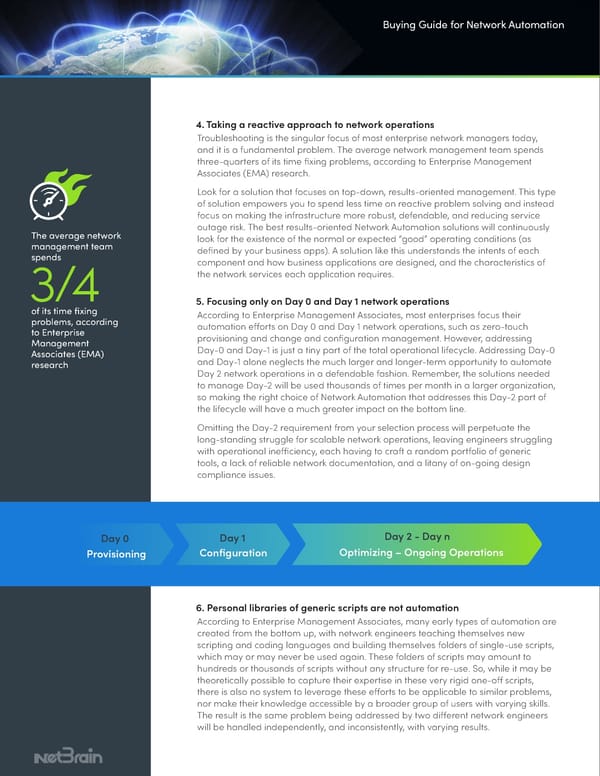Buying Guide for Network Automation 4. Taking a reactive approach to network operations Troubleshooting is the singular focus of most enterprise network managers today, and it is a fundamental problem. The average network management team spends three-quarters of its time fixing problems, according to Enterprise Management Associates (EMA) research. Look for a solution that focuses on top-down, results-oriented management. This type of solution empowers you to spend less time on reactive problem solving and instead focus on making the infrastructure more robust, defendable, and reducing service The average network outage risk. The best results-oriented Network Automation solutions will continuously management team look for the existence of the normal or expected “good” operating conditions (as spends defined by your business apps). A solution like this understands the intents of each component and how business applications are designed, and the characteristics of 3/4 the network services each application requires. 5. Focusing only on Day 0 and Day 1 network operations of its time fixing According to Enterprise Management Associates, most enterprises focus their problems, according automation efforts on Day 0 and Day 1 network operations, such as zero-touch to Enterprise provisioning and change and configuration management. However, addressing Management Day-0 and Day-1 is just a tiny part of the total operational lifecycle. Addressing Day-0 Associates (EMA) and Day-1 alone neglects the much larger and longer-term opportunity to automate research Day 2 network operations in a defendable fashion. Remember, the solutions needed to manage Day-2 will be used thousands of times per month in a larger organization, so making the right choice of Network Automation that addresses this Day-2 part of the lifecycle will have a much greater impact on the bottom line. Omitting the Day-2 requirement from your selection process will perpetuate the long-standing struggle for scalable network operations, leaving engineers struggling with operational inefficiency, each having to craft a random portfolio of generic tools, a lack of reliable network documentation, and a litany of on-going design compliance issues. Day 0 Day 1 Day 2 - Day n Provisioning Configuration Optimizing – Ongoing Operations 6. Personal libraries of generic scripts are not automation According to Enterprise Management Associates, many early types of automation are created from the bottom up, with network engineers teaching themselves new scripting and coding languages and building themselves folders of single-use scripts, which may or may never be used again. These folders of scripts may amount to hundreds or thousands of scripts without any structure for re-use. So, while it may be theoretically possible to capture their expertise in these very rigid one-off scripts, there is also no system to leverage these efforts to be applicable to similar problems, nor make their knowledge accessible by a broader group of users with varying skills. The result is the same problem being addressed by two different network engineers will be handled independently, and inconsistently, with varying results.
 Buying Guide For NetOps Page 4 Page 6
Buying Guide For NetOps Page 4 Page 6